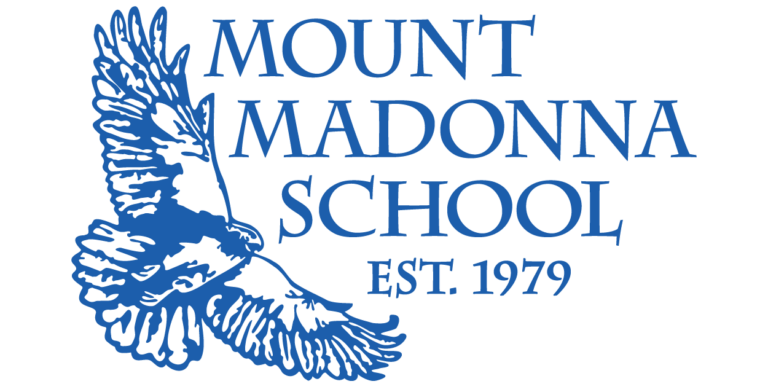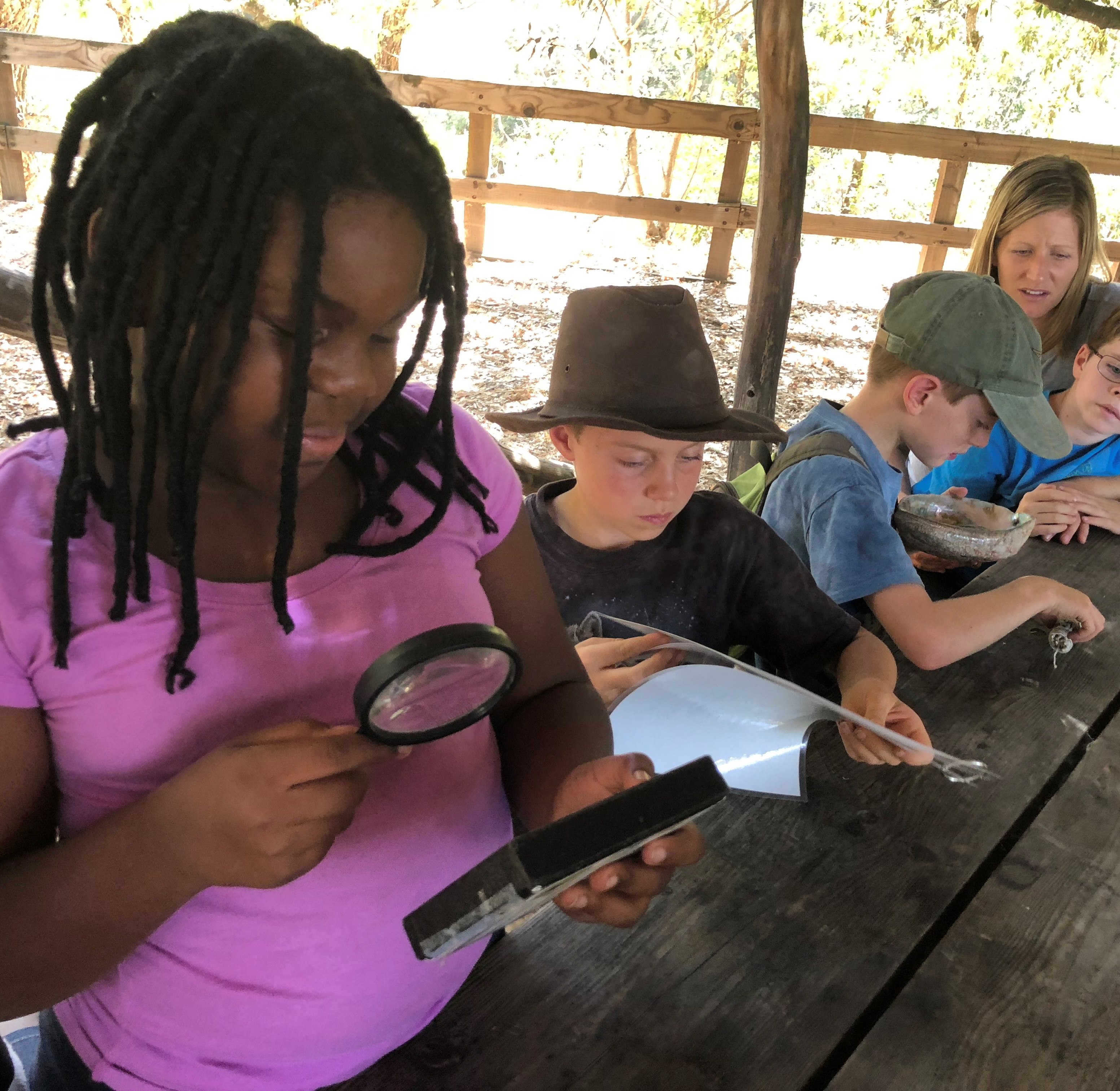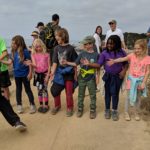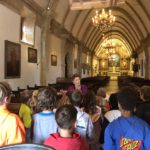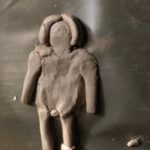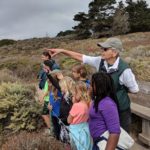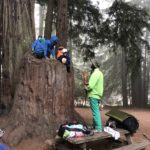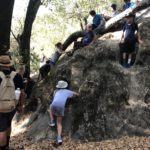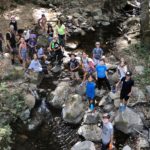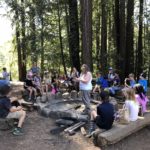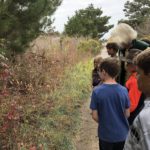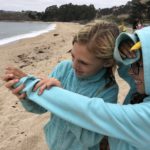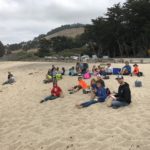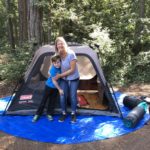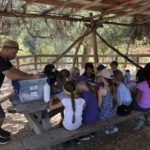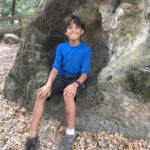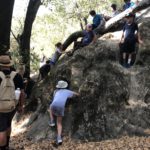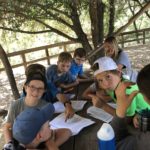Elementary Students Share a Two-Day, Overnight Learning Adventure
 Each fall, Mount Madonna School (MMS) third and fourth grade students take a two-day, overnight learning journey. These off-campus trips have alternated between Sacramento and the Coloma gold discovery site in the Sierras, to the central coast north of Santa Cruz to learn about the California history and ecology.
Each fall, Mount Madonna School (MMS) third and fourth grade students take a two-day, overnight learning journey. These off-campus trips have alternated between Sacramento and the Coloma gold discovery site in the Sierras, to the central coast north of Santa Cruz to learn about the California history and ecology.
This year, teachers Jenni Leach and Nicholas Cabassa designed a new learning journey to incorporate other historic and educational sites in this region, with visits to Mount Madonna County Park, Uvas Canyon County Park, Chitactac-Adams Heritage County Park, Point Lobos and the Carmel Mission.
Leach and Cabassa designed a trip to teach students social skills, social studies and science, while they explored, investigated and experienced learning in nature. They developed a curriculum around Mount Madonna School’s positive character and social service programs, the school’s academic curriculum map, and the longstanding MMS tradition of the learning journey.
 In the following, Leach shares descriptions and her reflections on their experiences.
In the following, Leach shares descriptions and her reflections on their experiences.
The goal of this trip was to teach students history and ecology through hands-on experiences. We wanted them to play and enjoy themselves as they learned, to practice cooperative skills and team build. Our hope was that they would discover a connection to history and environmentalism by living in nature, and re-enacting Native ways.
Our group headed to Mount Madonna County Park where we set up tents and unloaded supplies at the campsite. By helping to setup camp, students learned the importance of contributing effort for the group and the value of serving others.
Once camp was set, students freely explored the area and enjoyed climbing on and into huge redwood stumps left by loggers. One of our parent volunteers led the group in a gratitude circle, a Native American tradition of giving thanks to the earth for providing for all of our needs. The group shared dried white sage to bless the space and students made a promise to leave no trace. After we all gave gratitude, we packed up our lunches, and headed out for our next adventure.
 We went to Uvas Canyon County Park near Morgan Hill. Students noticed the variety of types of acorns blanketing the park’s picnic area, and began to compare and contrast their differences. They were able to identify and describe many of the parks trees and plants. They investigated the boulders and how trees have split rocks while growing. The picnic area provided a shady, lovely setting to investigate while having lunch.
We went to Uvas Canyon County Park near Morgan Hill. Students noticed the variety of types of acorns blanketing the park’s picnic area, and began to compare and contrast their differences. They were able to identify and describe many of the parks trees and plants. They investigated the boulders and how trees have split rocks while growing. The picnic area provided a shady, lovely setting to investigate while having lunch.
Next, we headed along the Waterfall Loop trail. Students took it upon themselves to go down to the water’s edge and explore the creek bed. They found snakes, newts, spiders and an array of insects to observe. A giant banana slug was spotted crossing the trail and small birds sang in the trees. They children were free to climb, run and stumble along the creek’s rocky path. They were ecstatic to have the freedom, to test their strength, their balance and their stamina while trudging up the creek. Some slipped, some fell, and some got wet. They cooperated and helped each other up and over boulders and fallen trees, down and through the creek. The pointed out and shared what they saw, enjoyed conversation and treated each other and the animals with respect and kindness. Uvas Canyon was a great place to let the students  experience nature and to run wild like the native children of the area did long ago.
experience nature and to run wild like the native children of the area did long ago.
Our next destination for the day was Chitactac-Adams Heritage County Park in Gilroy. The park provides a short but very informative interpretative trail with well-written information in both English and Spanish. Before we explored the self-guided trail, students heard about the native Ohlone people who used to inhabit the area, with information and artifacts from the Santa Clara County Parks and Recreation’s educational branch. Our students enjoyed touching, feeling and trying to manipulate small sticks to make fire; playing with musical instruments, using utensils and hunting tools, and imagining wearing deer skin clothing.
The students read about Ohlone village life and shared their understanding with each other. On the trail, they explored the bedrock mortars used to grind acorns, and discussed food sources, methods of hunting and gathering, and gender roles in providing food for the people. They looked for the ancient petroglyphs and questioned with curiosity why the spiral was so significant. They learned about the architecture and building materials and shared their thoughts on tule houses and boats. They questioned the people’s lack of clothing, and considered how cultural norms differ. The trail walk was not long, but filled with information and visual aids to give students a realistic understanding of the way the Ohlone people lived before the Europeans arrived.
 Students learned about the invasion and domination of the Europeans, and how it led to the destruction of the indigenous way of life, the introduction of foreign diseases that ended many native lives, and European farming practices, with domestic animals and non-native plants, that changed their healthy and natural diet. Students learned how the people lost their land and were forced to assimilate to European culture and customs, including their religion, language, education system, food, clothing, hairstyles, and architecture.
Students learned about the invasion and domination of the Europeans, and how it led to the destruction of the indigenous way of life, the introduction of foreign diseases that ended many native lives, and European farming practices, with domestic animals and non-native plants, that changed their healthy and natural diet. Students learned how the people lost their land and were forced to assimilate to European culture and customs, including their religion, language, education system, food, clothing, hairstyles, and architecture.
Our next stop was back to Mount Madonna County Park for an activity at the archery range and adjacent field. Teachers taught about the games Ohlone children played in order to improve their hunting skills. Students then enjoyed playing adapted traditional Ohlone games. First, our 20 students were split into two teams. Each team had their own color to cheer for as they took turns racing around cones, kicking a small, hard wooden ball. It was a relay race to improve speed, agility and stamina, all needed for hunting and catching small game.
 Next, the groups took turns at hunting games that involved precision and aim. Nick took half the group to the archery area where used a bow and arrow to aim for a target. Meanwhile the other students, went with Jenni to practice a simulated spearing game. Students used an unsharpened staff to aim and spear through a moving hoop, as if it were a large moving animal. The students said they really enjoyed playing these Native American games.
Next, the groups took turns at hunting games that involved precision and aim. Nick took half the group to the archery area where used a bow and arrow to aim for a target. Meanwhile the other students, went with Jenni to practice a simulated spearing game. Students used an unsharpened staff to aim and spear through a moving hoop, as if it were a large moving animal. The students said they really enjoyed playing these Native American games.
After the games we returned to our camp for some free play time while dinner was being prepared. Parents provided and prepared a delicious meal with beans, quesadillas, chips, salsa and salad. The hungry students were patient while they waited and gracious as they enjoyed the feast.
 After dinner and clean up, students were read a traditional Ohlone creation story. The story includes a conversation between eagle and crow, who want to make humans. They seek the help of badger, and get clay to make the first man and woman. While the story was being read, students were offered a handful of clay to create their own human or a “mini me.” Students enjoyed working the clay by lantern light as the story continued. The gist of the story is that people come from earth and in our end we will return to earth. So, as students finished their pieces, they were displayed for an art show, then brought to the base of an ancient redwood tree. Students were invited to say a wish for someone or all humanity as they placed their creation at the foot of the tree, where they would remain and once again become part of the earth. This lesson was deeply felt by students as they had just learned of the passing of Baba Hari Dass, the man who inspired the creation of Mount Madonna School and Mount Madonna Center, and had attended a moment of silence honoring him earlier in the week.
After dinner and clean up, students were read a traditional Ohlone creation story. The story includes a conversation between eagle and crow, who want to make humans. They seek the help of badger, and get clay to make the first man and woman. While the story was being read, students were offered a handful of clay to create their own human or a “mini me.” Students enjoyed working the clay by lantern light as the story continued. The gist of the story is that people come from earth and in our end we will return to earth. So, as students finished their pieces, they were displayed for an art show, then brought to the base of an ancient redwood tree. Students were invited to say a wish for someone or all humanity as they placed their creation at the foot of the tree, where they would remain and once again become part of the earth. This lesson was deeply felt by students as they had just learned of the passing of Baba Hari Dass, the man who inspired the creation of Mount Madonna School and Mount Madonna Center, and had attended a moment of silence honoring him earlier in the week.
Before bedtime students celebrated their full day of learning experiences with a warm campfire. We had learned just the day before that we could not have a wood fire, so one of our parents brought a propane fire pit to our site. The students negotiated with parents and teachers about how many s’mores (or variations of the ingredients) they could have, and took turns at being safe at the fire pit. Our last activity of the night was a short night hike to a nearby open meadow. Students enjoyed gazing at starts and identifying constellations and sighting flying objects. Then, after brushing teeth and washing up at a nearby spigot, students were tucked into their warm and safe tent beds.
 The next morning, students and parents woke up surrounded by fog. The forest was dripping and the air was cool, but everyone was excited about the day. Parents enjoyed hot coffee while they prepared the breakfast buffet. Once ready, students enjoyed a hearty breakfast of eggs, crepes, muffins, cereal, yogurt and fruit. The parents were essential in the shopping, preparing and serving the meals. The kids enjoyed a morning of forest play before the pack up for more ‘on the road’ learning adventures.
The next morning, students and parents woke up surrounded by fog. The forest was dripping and the air was cool, but everyone was excited about the day. Parents enjoyed hot coffee while they prepared the breakfast buffet. Once ready, students enjoyed a hearty breakfast of eggs, crepes, muffins, cereal, yogurt and fruit. The parents were essential in the shopping, preparing and serving the meals. The kids enjoyed a morning of forest play before the pack up for more ‘on the road’ learning adventures.
We left Mount Madonna Park and headed to Carmel. Our first destination was the Carmel Mission or Mission San Carlos Borromeo del rio Carmelo first built in 1797. We were hosted by an engaging docent who was very knowledgeable about the mission, its history, and Catholicism. Our students were inquisitive and curious about the information our docent shared. I was impressed with their questions, reminded of the diversity in our school and pleased with their thoughtful behaviors as a group of 20 young students! After learning about the early arrival of the Spanish in this area, and many ways in which it impacted life for indigenous people, we headed to Missionary Beach for a lunch break.
 Everyone seemed to appreciate this change of pace. The bay is so beautiful there and the temperature was just right! The students imagined being there before the missionaries, before the Europeans and before the industrial revolution. We were not able to get wet, as we had yet one more destination before our day was through.
Everyone seemed to appreciate this change of pace. The bay is so beautiful there and the temperature was just right! The students imagined being there before the missionaries, before the Europeans and before the industrial revolution. We were not able to get wet, as we had yet one more destination before our day was through.
Our final stop on this overnight learning journey was a docent-led tour at Point Lobos State Natural Reserve. Although the students were a bit tired, they gave their full attention and respect to the volunteer who guided us along an ocean cliff walk. They told the children about the rocks, plants and animals of the reserve, and about the importance of preservation. The students again, asked excellent questions and shared their knowledge. All three docents exclaimed how the MMS students were some of the smartest and best-behaved groups they have worked with. As a teacher, I am always so pleased to hear these glowing reviews!
 The group worked well together, without conflict or issues. After we returned home, one parent, Adrienne Krawetz, wrote and shared her appreciation:
The group worked well together, without conflict or issues. After we returned home, one parent, Adrienne Krawetz, wrote and shared her appreciation:
Thank you for a super rewarding experience! I always knew Mount Madonna was a ‘gift of a place’ for my girls to be, but you and Nick really drove that point home during this trip – it was educational, well-planned, well-paced, good exercise, good food, beautiful locations, and I particularly appreciated the Native American focus.
The girls had a blast, great team building and strength building, and a lifetime of memories for our family. I feel so grateful to be able to be a part of Mount Madonna myself, and if I can help out in any way on future trips I will most certainly do.
 “It was a great experience and bonding adventure for our two classes,” shared my colleague and trip co-leader Nick Cabassa. “The fourth graders are taught to look after their third grade buddies and this trip gave them the opportunity to really do that outside of school. This trip is brand new to our curriculum and as such, it was difficult to predict how it was going to all work out. Now that it is over and we’ve written some reflections, I’ve seen that the children had an awesome experience, and can’t stop talking about it. It was a fun and educational trip, and well worth doing on a semi-annual basis.”
“It was a great experience and bonding adventure for our two classes,” shared my colleague and trip co-leader Nick Cabassa. “The fourth graders are taught to look after their third grade buddies and this trip gave them the opportunity to really do that outside of school. This trip is brand new to our curriculum and as such, it was difficult to predict how it was going to all work out. Now that it is over and we’ve written some reflections, I’ve seen that the children had an awesome experience, and can’t stop talking about it. It was a fun and educational trip, and well worth doing on a semi-annual basis.”
In conclusion, we completed our time together with a closing gratitude circle before heading home. This experiential learning journey was the best field trip I have ever been on, and I hope to have the opportunity to repeat it with other students in the years ahead!
Click on photos in the album below to view them full size
####
Contact: Leigh Ann Clifton, director of marketing & communications,
Nestled among the redwoods on 355 mountaintop acres, Mount Madonna is a safe and nurturing college-preparatory school that supports students in becoming caring, self-aware and articulate critical thinkers, who are prepared to meet challenges with perseverance, creativity and integrity. The CAIS and WASC accredited program emphasizes academic excellence, creative self-expression and positive character development. Located on Summit Road between Gilroy and Watsonville.
